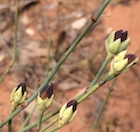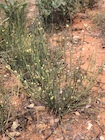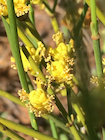Ephedra coryi
E.L. Reed 1936
Common names
Cory's ephedra (Stevenson 1993).
Taxonomic notes
Type locality Brownfield, Texas (Reed 1936). No synonyms recorded, though a plant initially described as Ephedra coryi var. viscida H.C. Cutler has been placed into synonymy with E. cutleri.
Description
"Shrubs rhizomatous, forming clumps, erect, 0.25-1.5 m, 3-5 m diam. Bark red-brown, cracked and irregularly fissured. Branches alternate or whorled, becoming rigid, angle of divergence about 25°. Twigs bright green, becoming yellow-green with age, not viscid, ridges between longitudinal grooves papillate, slightly scabrous; internodes 2-5 cm. Terminal buds conic, 1-3 mm. Leaves opposite, 2-5 mm, connate to 1/2-3/4 their length; bases thickened, brown, persistent, becoming hard, enlarged, and black; apex acute. Pollen cones 2-several at node, obovoid, 4-6 mm, on very short, scaly peduncles (rarely sessile); bracts opposite, 5-9 pairs, light yellow, ovate, 2-4 × 2-3 mm, membranous, slightly connate at base; bracteoles slightly exceeding bracts; sporangiophores 2-4 mm, 1/4 exserted, with 5-7 sessile to short-stalked (less than 1 mm) microsporangia. Seed cones 2-several at node, obovoid to nearly globose, 7-15 mm, on smooth peduncles, 5-25 mm, with 1 pair of basal and 1 pair of nearly terminal bracts, at least in early cones; bracts opposite, 3-4 pairs, ovate to circular, 5-8 × 5-12 mm, inner pairs becoming fleshy (at least centrally) and orange at maturity. Seeds 2, ellipsoid, 5-8 × 2-4 mm, brown to chestnut, smooth. ... Coning March-April" (Stevenson 1993). Note that this is the only North American Ephedra with fleshy, orange seed cones, and shares with E. cutleri the rhizomatous habit.
Stevenson (1993) provides this Key to the North American species of Ephedra.
Distribution and Ecology
US: New Mexico & Texas at 500-2300 m in sandy, semiarid areas. In New Mexico it is represented only by an isolated population in the Caballo Mountains; peduncles of these plants are only 5-10 mm long (Stevenson 1993, R. Spellenberg email 2009.11.19).
Remarkable Specimens
No data as of 2023.03.03.
Ethnobotany
Observations
See the observations on iNaturalist, accessed 2021.12.29.
Remarks
The epithet remembers V. L. Cory, range botanist at the Texas Agricultural Experiment Station (Reed 1936).
Citations
Reed, E. L. 1936. Ephedra coryi Bull. Torrey Bot. Club 63: 351-353. [not available online]
See also
Species profile at Plants of the World Online, accessed 2021.12.29.



